
The speartooth shark is a rare species of river shark, belonging to the family Carcharhinidae. It inhabits coastal marine waters and tidal reaches of large tropical rivers in northern Australia and New Guinea. Despite being a member of the river shark genus, it is also found in near-shore marine waters, favoring highly turbid environments over a wide range of salinities. This robustly built, gray-colored shark is characterized by a short and broad snout, tiny eyes, a relatively large second dorsal fin, and a black blotch beneath each pectoral fin near the tip. Another identifying trait is its teeth, which are large, triangular, and serrated in the upper jaw and narrow, spear-like, and serrated only near the tips in the lower jaw. Adults grow to about 2.6 m (8.5 ft) long.
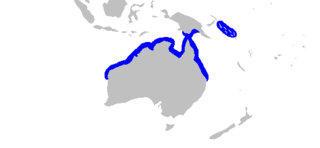
The nervous shark is a species of requiem shark, and part of the family Carcharhinidae, so named because of its timid behavior in regard to humans. It is common in shallow, coastal waters off northern Australia, Papua New Guinea, and the Solomon Islands. A small brownish or grayish shark typically measuring 1.0–1.3 m (3.3–4.3 ft) long, this species has a short, blunt snout, oval eyes, and a relatively large second dorsal fin. The leading margins of most fins are finely edged with black, and the lower caudal fin lobe is black-tipped.

The Mexican hornshark is a bullhead shark of the family Heterodontidae. This shark is grey-brown in color, with black spots scattered on the fins and body. It has a cylindrical trunk, conical head, and small spiracles behind the eyes. The snout of the Mexican hornshark is very round and blunt. Like all members of the order Heterodontiformes, this shark has fin spines in front of both of its dorsal fins. The first dorsal fin originates before the pectoral fins, while the second dorsal fin originates behind the pelvic fins. The Mexican hornshark reaches a maximum length around 70 cm, but usually reaches between 50 and 60 cm on average. Young hornsharks hatch around 14 cm.

The sharpfin houndshark is a houndshark of the family Triakidae. Only two specimens have been found, both in the coastal waters of Ecuador, the longest one being 1.02 m in length. The reproduction of this houndshark is ovoviviparous.
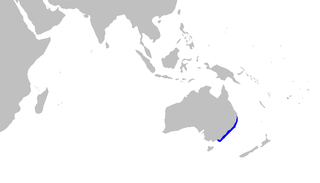
The Australian spotted catshark is a catshark of the family Scyliorhinidae, found only around Australia between 32 and 38°S, at depths between 10 and 180 m. It can grow up to 90 cm. Females of this species were observed as being reproductive year round. They are also confirmed as being a single oviparous species.
The dwarf catshark is a catshark of the family Scyliorhinidae, found only off the coast of Western Australia, at depths between 200 and 400 m. Its length is up to 44 cm.

The speckled catshark is a catshark of the family Scyliorhinidae. It is found in the Gulf of Aden and off the coast of Somalia. It occurs at depths of between 37 and 250 m. Its length is up to 48 cm.
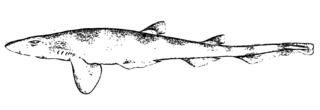
The Antilles catshark is a common but little-known species of catshark, part of the family Scyliorhinidae. It is found on or near the bottom at a depth of 293–695 m (961–2,280 ft) off Florida and the West Indies from Jamaica to Martinique. It was once regarded as a subspecies of the similar roughtail catshark, along with the longfin sawtail catshark. Growing to 46 cm (18 in) long, the Antilles catshark is a slender species with a marbled color pattern of dark saddles and blotches, as well as a crest of enlarge dermal denticles along the front part of its dorsal caudal fin margin. It feeds on shrimp and may have schooling habits. Reproduction is oviparous.

The Australian sawtail catshark is a common species of catshark, and part of the family Scyliorhinidae, endemic to southern Australian waters. It is found on or near the bottom of the outer continental shelf and upper continental slope, at depths of 85 to 823 m. This slim-bodied species is characterized by crests of enlarged dermal denticles along both the dorsal and ventral edges of its caudal fin and caudal peduncle, along with a color pattern of broad, dark saddles outlined in white. It can grow to 61 cm (24 in) in length. The Australian sawtail catshark feeds mainly on fishes, crustaceans, and cephalopods. Females are oviparous and lay eggs enclosed by capsules. This species is often caught incidentally by commercial bottom trawl fisheries, but is not significantly threatened by fishing activity. Thus, it has been assessed as of Least Concern by the International Union for Conservation of Nature (IUCN).

The ornate angelshark is an angelshark of the family Squatinidae endemic to southern Australia between latitudes 30°S and 35°S, at depths of 130–400 m (430–1,310 ft). It can reach lengths of up to 1.4 m (4.6 ft). Females tend to have a TL at 1150–1250 mm, while males range from a TL of 810–910 mm at sexual maturity. Reproduction is ovoviviparous, with two to nine pups per litter.
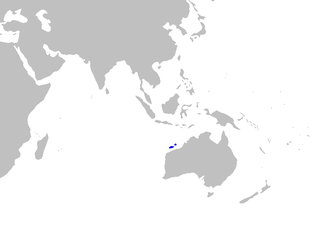
The pygmy lanternshark is a shark of the family Etmopteridae found in the eastern Indian Ocean from northern Western Australia and possibly Java, at depths of between 430 and 550 m. Its length is up to 26 cm.
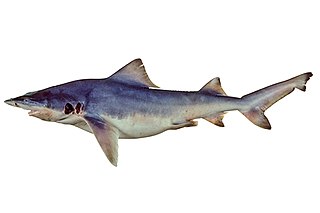
The northern river shark or New Guinea river shark is a species of requiem shark, in the family Carcharhinidae, found in scattered tidal rivers and associated coastal waters in northern Australia and in Papua New Guinea. This species inhabits areas with poor visibility, soft bottoms, and large tides, with immature sharks ranging into fresh and brackish water. It is similar to other river sharks in having a stocky grey body with a high back, tiny eyes, and broad fins. It measures up to 2.5 m (8.2 ft) long.

The Natal shyshark, eastern shyshark or happy chappie is a species of catshark, belonging to the family Scyliorhinidae. It was once regarded as the "Natal" form of the puffadder shyshark. This shark is endemic to a small area off South Africa from the Western Cape to KwaZulu-Natal. It is found close to the coast, from the surf zone to a depth of 30 m (98 ft), and has benthic habits. Reaching 50 cm (20 in) in length, the Natal shyshark is similar to the puffadder shyshark in appearance but has a stockier body, less flattened head, a compressed caudal peduncle, and a different color pattern. Rare and under threat from habitat degradation and commercial fishing, it has been assessed as Vulnerable by the International Union for Conservation of Nature (IUCN).

Hydrolagus mitsukurii is a species of fish in the family Chimaeridae found in China, Japan, South Korea, the Philippines, Taiwan, and possibly Indonesia. Its natural habitat is open seas. It is one of several species commonly called "spookfish".

The widenose guitarfish is a species of fish in the Glaucostegidae family. It is found in Bangladesh, Indonesia, Malaysia, Myanmar, Pakistan, Sri Lanka, and Thailand. Its natural habitats are open seas, shallow seas, coral reefs, and estuarine waters.
The roughnose wedgefish is a species of fish in the Rhinidae family. It is found in Indonesia and Singapore. Its natural habitats are open seas, shallow seas, coral reefs, estuarine waters, and coastal saline lagoons. It is threatened by habitat loss. Despite having been known for more than a decade, it remained undescribed until 2016. This is a relatively small species, reaching up to 81 cm (2.66 ft) in length. Adults are greenish-brown above; young have white spots.
The broadnose wedgefish is a species of fish in the Rhinidae family. It is found in coastal and estuarine habitats in southeast Asia, where documented from Java, Borneo, Singapore, the Philippines and Thailand. It is threatened by habitat loss and overfishing. This is a medium-sized species of Rhynchobatus, which reaches a maximum length of about 2.15 m (7.1 ft).
Figaro is a genus of catshark, and part of the family Scyliorhinidae. Until 2008, Figaro was generally considered to be a subgenus of Galeus. The two known species are found off Australia, inhabiting deep, offshore waters on or near the bottom. Figaro contains small, slender, firm-bodied sharks that bear distinctive crests of enlarged, spiny dermal denticles along the dorsal and ventral edges of their short caudal fins. The caudal peduncle is relatively long, such as that the anal and caudal fins are some distance apart. In adult males, the inner margins of the pelvic fins are fused together to form a subtle "apron" over the claspers. F. boardmani is a predator of fishes, crustaceans, and cephalopods, and is oviparous; less is known about the F. striatus. Both are harmless and are of no economic importance.















